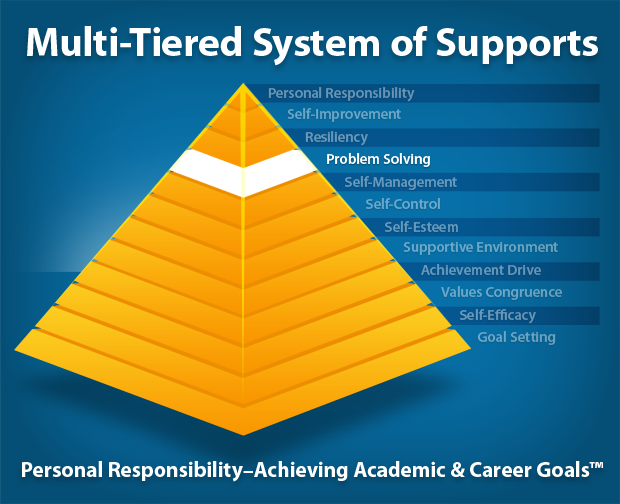
The topic today is on problem solving, the ninth scale of twelve in our Personal Responsibility Map®, which is a core assessment in our Personal Responsibility—Achieving Academic and Career Goals™ program. Problem solving is the ability to work through problems and use thinking skills to arrive at good goal solutions.
Multi-Tiered System of Supports, or MTSS, is a term used to describe an evidence-based model of schooling that uses data-based problem solving to integrate academic and behavioral instructions and intervention (Florida’s MTSS Project). This definition brings together the worlds of academic instruction and behavioral intervention.
It is interesting that in the definition of MTSS, problem solving (for staff) is the key to solving academic and behavioral issues (for students). Just as problem solving is a critical skill for staff in the MTSS process, it is equally important for students.
Victor Frankel is one of my personal mentors. Victor’s job while in a Nazi concentration camp was to clean out and bury the bodies from the gas chambers, including his own family members. While under that great duress, he managed to keep a positive attitude, for he understood something that no one else understood. They could take away all of his freedoms but one—his ability to think and to choose his attitude. That is the true essence of problem solving—to think and to choose a course of action.
Problem Solving is Not Decision Making
Webster’s New World Dictionary defines a problem as a question that needs a solution. Solution is defined as the act of solving a problem. When we compare problem solving to decision making, what we find is that problem solving comes before the decision-making process.
Problem solving means being forced to make a decision about things beyond one’s control. Decision making means to choose to make a decision because you wish for something to happen that is not currently happening.
Decision making happens because you want something to happen. Problem solving happens when it becomes clear that there are unsettled or unsolved questions.
Decision making follows problem solving. Once possible solutions are identified, the decision-making process kicks in to decide how to choose the best solution. Decision making means “a final choice.” Decision making puts the problem-solving process to work.
In our problem solving skill intervention system, participants learn our five-step problem solving process:
| Step 1 | Find the problem |
| Step 2 | Define the problem |
| Step 3 | Describe the problem |
| Step 4 | Diagnose the problem |
| Step 5 | Test the diagnosis |
Once the five-step problem-solving process is complete, the four-step decision making process can begin:
| Step 6 | Decide on a plan |
| Step 7 | Use the plan |
| Step 8 | Test the results |
| Step 9 | If needed, adjust your problem-solving plan |
Click here to learn more about Personal Responsibility!
